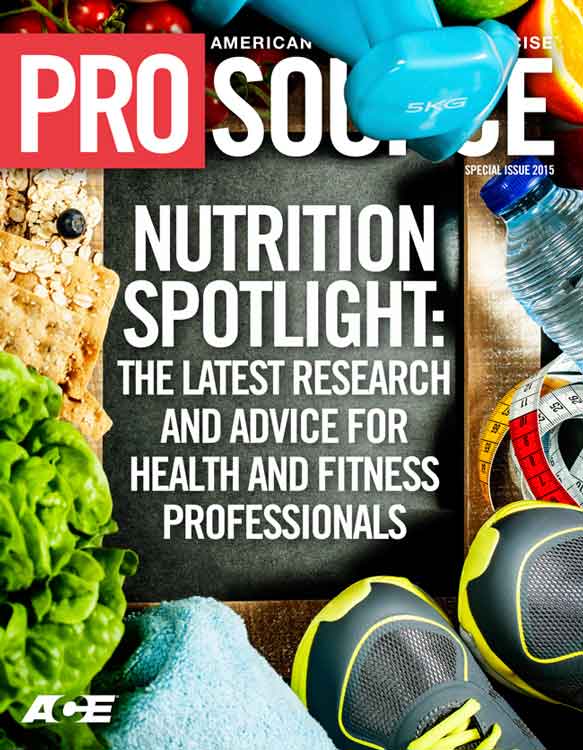
To say that Americans have a sweet tooth is an understatement. The average American consumes 32 teaspoons of added sugar a day, well over the 10 teaspoons (roughly the amount of sugar in a 12-ounce soda) the USDA recommends on a 2,000-calorie-a-day diet.
Breaking it down further, the dietary guidelines recommend that people limit discretionary calories, which includes both added sugars and solid fats, to no more than 5 to 15 percent of their total daily caloric intake. Yet Americans get an average of 16 percent of their daily calories from added sugars alone, according to the FDA.
People are clearly enjoying a sweet life. Yet it doesn’t come without health consequences, some so severe that many experts believe it’s time to get serious about lowering sugar intake. Here’s what you need to know to help clients tame that sweet tooth.
Where Sugar’s Coming From
When discussing sugar, you have to distinguish between naturally occurring sugars like those in fruit and milk, and added sugars, which have been added to foods and beverages when they’re processed or prepared. The more dangerous of the two? Hands down, added sugar.
Spotting Hidden Sugars
You might say added sugar is a master of disguise because it appears under numerous names—56 in all, says Lustig, whose book, Sugar Has 56 Names (Penguin Group, 2013), includes a comprehensive list. This is why reading food labels is critical.
Here’s a small sample of these deceptive names:
- Anhydrous dextrose
- Brown sugar
- Cane juice
- Confectioner’s powdered sugar
- Corn syrup
- Corn syrup solids
- Crystal dextrose
- Dextrose
- Evaporated corn sweetener
- Fructose
- Fruit juice concentrate
- Glucose
- High-fructose corn syrup
- Honey
- Invert sugar
- Lactose
- Liquid fructose
- Malt syrup
- Maltose
- Maple syrup
- Molasses
- Nectars (like peach or pear nectar)
- Pancake syrup
- Raw sugar
- Sucrose
- Sugar cane juice
- White granulated sugar
“Added sugars cause very real and devastating health consequences,” says Robert H. Lustig, M.D., professor of pediatrics in the division of endocrinology at the University of California, San Francisco, author of Fat Chance (Hudson Street Press, 2013) and president of the Institute for Responsible Nutrition. Fruit, on the other hand, he says, is good for you because it contains fiber, which limits the rate of sugar absorption so the liver isn’t hit with sugar all at once.
Trouble is, though, added sugars aren’t always easy to spot. “While eating sugar is often a conscious decision—you’ve chosen, for instance, to eat a piece of cake—most people don’t know how much sugar is added to foods they wouldn’t ordinarily think of as being indulgent,” says Brooke Alpert, M.S., R.D., C.D.N., founder of B Nutritious in New York City and co-author of The Sugar Detox (Da Capo, 2013).
Sugar is, in fact, so prevalent in today’s food supply that the USDA calls it “the number one food additive.” The top five added sugars in the American diet include sucrose (table sugar), high-fructose corn syrup, honey, agave syrup and maple syrup, Lustig says. While sugar-sweetened beverages like soda account for 37.1 percent of added sugar in the American diet, other top contributors include grain-based desserts (think cookies, brownies and cakes), fruit drinks, dairy desserts like ice cream and yogurt, candy, ready-to-eat cereals and yeast bread, according to a study published in JAMA Internal Medicine.
Manufacturers add sugar to foods for several reasons, none of which take into account consumers’ health. The most obvious? Sugar makes food taste better. “By making foods more palatable, people will eat more,” says Yoni Freedhoff, M.D., assistant professor of family medicine at the University of Ottawa in Ontario, Canada, founder and medical director of the Bariatric Medical Institute in Ottawa, and author of The Diet Fix (Harmony Books, 2014). Freedhoff adds that companies are even studying how to engineer foods so they’re as palatable as possible to drive up consumption.
Another concerns cost. “Adding sugar makes foods cheaper to produce,” Lustig says.
Sugar’s Not-so-sweet Side
You probably equate excess sugar with weight gain. While that potential does exist—one teaspoon of table sugar, after all, contains 15 calories, and too much sugar might account for a small percentage of the obesity epidemic, Lustig says—the greater danger lies in how sugar increases the risk of developing diseases associated with metabolic syndrome.
 When you eat sugar, Lustig explains, your body metabolizes only the fructose, or the sweet part of sugar, in the liver. Large amounts overwhelm the capacity of the mitochondria, energy-burning factories in your cells. When overloaded, the mitochondria have no choice but to turn that fructose into liver fat, which drives insulin resistance. Without getting too complicated, that can then lead to the development of metabolic disorders like type 2 diabetes, heart disease, hypertension and lipid problems.
When you eat sugar, Lustig explains, your body metabolizes only the fructose, or the sweet part of sugar, in the liver. Large amounts overwhelm the capacity of the mitochondria, energy-burning factories in your cells. When overloaded, the mitochondria have no choice but to turn that fructose into liver fat, which drives insulin resistance. Without getting too complicated, that can then lead to the development of metabolic disorders like type 2 diabetes, heart disease, hypertension and lipid problems.
Take, for instance, the recent headline-grabbing study from JAMA Internal Medicine, which found that higher intake of added sugars is associated with an increased risk of cardiovascular disease death. Compared to people who consumed only 8 percent of their calories from added sugar, people who consumed 17 to 21 percent of calories from added sugar had a 38 percent higher risk of cardiovascular disease death. For those who went above 21 percent, their risk more than doubled.
Sugar, which is obviously known to cause cavities, has also been indirectly linked to an increased risk for cancer and dementia. It may even cause premature aging of the skin, Alpert says.
What’s more, certain individuals could become addicted to sugar. Lustig likens this to alcohol addiction. “While 41 percent of Americans are social drinkers, meaning that they can have a drink and walk away, roughly 20 percent of the population is addicted to alcohol,” he says. Sugar addiction is similar in that there are certain individuals who are more susceptible. “For these people, they need to eat more sugar to experience the same feeling of reward.”
Even if you don’t reach addiction level per se, there’s still a chance that the more sweet stuff you eat, the more you’ll desire. Freedhoff is especially worried this is happening in children who are being given sugary products around the clock to keep them happy. “We’re teaching kids that all foods and beverages must be sweet, and that’s only going to make the obesity epidemic in children worse,” he says.
Scaling Back the Sugar
The above data should table any debate that Americans need to rein in their sugar habit. The real question, however, is this: With sugar being so prominent in foods and beverages—“it’s nearly impossible to buy a processed food that doesn’t contain added sugar,” Lustig says—how do you cut it? And just how much is too much?
You’ve probably heard clients ask those same questions. Trouble is, there are no easy answers, and while it’s close to impossible to consume a diet completely void of added sugars, people can limit their intake.
When it comes to determining how much is too much, though, different organizations have varying recommendations. The Institute of Medicine says added sugars should make up no more than 25 percent of total calories consumed, while the World Health Organization (WHO) has set the limit at 10 percent. However, WHO is currently considering cutting the daily allowance of added sugars to 5 percent, which Lustig believes is low. “You’d have to work really hard to get below that,” he says.
Meanwhile, the American Heart Association recommends consuming no more than 8 percent of total calories from added sugars, a guideline Lustig helped create. “Although this is a rational threshold, it’s still going to be tough for most people,” he says.
That doesn’t mean, though, people shouldn’t take steps to eliminate as much added sugar as they can from their diets. While Alpert recommends going cold turkey, Freedhoff says it’s best to reduce sugar gradually so the palate doesn’t notice. Here are four strategies you can suggest to clients:
1. Eliminate sugar-sweetened beverages. “Don’t drink your calories or your sugar,” Alpert says. That goes for any beverage with sugar, especially soda, even diet sodas, as the artificial sweeteners can increase your desire for sweets, Alpert says. Other sugar-laden beverages include orange juice (“with the same amount of sugar and calories as soda, it’s little more than liquid candy with vitamins,” Freedhoff says), flavored milks and sports drinks. Only if you spend hours working out should you use sports drinks, Lustig adds.
And yes, the above advice includes sugar in coffee. If your clients struggle with the taste of straight black coffee, Alpert recommends unsweetened iced coffee, as it’s more palatable.
2. Make dessert an occasional, not daily, splurge. While it’s okay to have an occasional dessert, it shouldn’t be a daily event, even an every-meal occurrence, as it often is in today’s society. Instead, choose your desserts wisely, making it a conscious indulgence, and reduce overall sugar intake that day. “If you know you’re going to be eating dessert after dinner, keep your sugar intake low throughout the day,” Alpert says.
The one exception in Alpert’s book? An ounce of dark chocolate with at least 65 percent cacao, which she says can be a daily treat, as it’s loaded with antioxidants. If, though, you won’t be able to stop at an ounce, don’t start this habit.

3. Read food labels. In February, the FDA proposed new food label guidelines, including adding a line that lists the amount of added sugars in products. Until those changes take effect, pay extra attention to labels (see sidebar for a list of hidden sugars). If you see any of these names in products, don’t buy them, Alpert says. (Her book, by the way, includes a grocery list with products that don’t contain added sugars.)
4. Give up refined carbohydrates like white rice, white bread and white flour. Instead, switch to brown versions of these foods. “Just keep portions in check,” Alpert says.
Surprisingly, there is another way to help protect the body against the effects of added sugars, which could give your clients extra motivation to get to the gym: Get regular exercise. “Exercise increases the metabolism of mitochondria,” Lustig says. “If you’ve eaten too much sugar, exercise—and the more, the better—may help prevent mitochondria from being overloaded, which means they wouldn’t turn the sugar into fat.”
There’s no question that cutting added sugar is no simple task, but living this sweet life really isn’t so, well, sweet.





 by
by 

 When you eat sugar, Lustig explains, your body metabolizes only the fructose, or the sweet part of sugar, in the liver. Large amounts overwhelm the capacity of the mitochondria, energy-burning factories in your cells. When overloaded, the mitochondria have no choice but to turn that fructose into liver fat, which drives insulin resistance. Without getting too complicated, that can then lead to the development of metabolic disorders like type 2 diabetes, heart disease, hypertension and lipid problems.
When you eat sugar, Lustig explains, your body metabolizes only the fructose, or the sweet part of sugar, in the liver. Large amounts overwhelm the capacity of the mitochondria, energy-burning factories in your cells. When overloaded, the mitochondria have no choice but to turn that fructose into liver fat, which drives insulin resistance. Without getting too complicated, that can then lead to the development of metabolic disorders like type 2 diabetes, heart disease, hypertension and lipid problems. 

